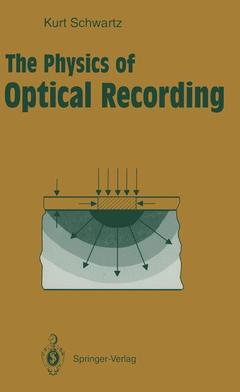The Physics of Optical Recording, Softcover reprint of the original 1st ed. 1993
Langue : Anglais
Auteur : Schwartz Kurt

Optics and optical recording have a long history. Already in the ancient temples of Egypt and in Stonehenge, optical imaging was used in religious ceremonies. As early as the 17th century, optical instruments such as the telescope and the microscope played a crucial role in the development of the natural sciences, which, in turn, altered humanity's perception of itself and the universe. Nowadays, the science of optics is not only a means of gathering information but, also, of information transfer, analysis and processing. Our reliance on optical computing has become crucial since 1982, when compact discs (CD's) first became widely available. Optical memory discs, CD ROM (read-only memory), WORM (write-once-read many) and erasable read-write discs are now produced industrially. However, WORM and erasable discs comprise only a small field of optical imaging and information processing. Recent research into optical recording introduced new horizons for optical computing and real time information processing, such as, three-dimensiomil holographic memory, time-domain holography, nonlinear optical filtering, etc. The development of these unique possibilities is conceivable only with new recording materials and novel recording processes. For such progress, one should be familiar with the "pen and paper" of optical recording - the laser and the optical medium. Thus, this book will be a guide to novel applications of optical recording materials. The reader will find a description of the principles of optical recording and optical processing, which allow him to find novel applications for information storage and optical imaging.
1. Introduction.- 1.1 Visual Impressions and Optics.- 1.2 Imaging in the Eye and Optical Recording.- 1.3 Digital and Holographic Recording.- 1.4 Recording Time and Data Rate.- 1.5 Storage Capacity.- 1.6 Applications of Real Time Optical Recording.- 2. The Principles of Optical Recording.- 2.1 The Invention of Photography and Real Time Recording.- 2.2 Optical Recording Processes.- 2.3 Survey of Optical Recording Media and Their Uses.- 2.4 Holography.- 2.4.1 Recording and Readout.- 2.4.2 Hologram Classifications.- 2.4.3 Diffraction Efficiency.- 2.4.4 Resolution and Storage Capacity.- 2.4.5 Holographic Optical Elements.- 2.5 Light Sensitivity of Recording Materials.- 3. Lasers, Nonlinear Optics and Photoelectric Detectors.- 3.1 Absorption and Emission of Light.- 3.2 Lasers.- 3.2.1 Population Inversion.- 3.2.2 Principle of Operation.- 3.3 Nonlinear Optics.- 3.3.1 Nonlinear Absorption.- 3.3.2 Second Order Polarization.- 3.3.3 Second Harmonic Generation and Phase Matching.- 3.4 Light Modulation.- 3.4.1 Electro-Optic Modulators.- 3.4.2 Magneto-Optic Modulators.- 3.4.3 Acousto-Optic Modulators.- 3.5 Photoelectric Detectors.- 4. Photoinduced Processes in Optical Recording Materials.- 4.1 Inorganic Photochromic Crystals.- 4.1.1 Light Induced Charge Transfer Reactions.- 4.1.2 Anisotropic Photochromic Effect.- 4.1.3 Light Induced Aggregation of F-Centers.- 4.1.4 Phase Hologram Recording in Photochromic Materials.- 4.2 Photorefractive Materials.- 4.2.1 The Mechanisms of Photorefraction in Ferroelectrics.- 4.2.2 Optical Recording in LiNbO3.- 4.2.3 Recording of Phase Holograms.- 4.3 Chalcogenide Semiconductors.- 4.3.1 Atomic Structure Ill.- 4.3.2 Electronic Structure.- 4.3.3 Photoinduced Processes.- 4.3.4 Optical Recording.- 4.3.5 Holographic Recording.- 4.4 Organic and Polymer Materials.- 4.4.1 Camphorquinone.- 4.4.2 Bacteriorhodopsin.- 4.4.3 Reoxan.- 4.4.4 Thermoplastic Recording Media.- 4.5 Persistent Spectral Hole Burning.- 4.5.1 Frequency Domain Optical Storage.- 4.5.2 Time-Domain Holography.- 5. Digital Recording on Optical Memory Discs.- 5.1 Commonly Available Optical Memory Discs.- 5.1.1 Multilayered Recording Media.- 5.1.2 Components of the Recording and Reading System.- 5.2 Photothermal Recording.- 5.2.1 Irreversible Recording in Tellurium Compounds.- 5.2.2 Reversible Recording in Tellurium Compounds.- 5.2.3 Photothermal Recording in Antimony Compounds.- 5.2.4 Magneto-Optic Recording.- 5.3 Light Stimulated Recombination Luminescence.- 6. Summary and Looking Ahead.- References.- Recording Medium Index.
Date de parution : 02-2012
Ouvrage de 191 p.
15.5x23.5 cm
Disponible chez l'éditeur (délai d'approvisionnement : 15 jours).
Prix indicatif 52,74 €
Ajouter au panier
© 2024 LAVOISIER S.A.S.



